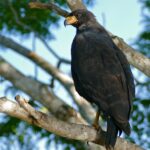Great black hawks are large, powerful birds of prey that are known for their impressive hunting skills and distinctive vocalizations. These majestic birds use a variety of communication methods to convey information, establish territories, and interact with their mates and offspring. In this blog post, we’ll explore the different ways great black hawks communicate and how they use these methods to thrive in their natural habitats.
Vocalizations: The Language of Great Black Hawks
The primary mode of communication for great black hawks is through vocalizations. These birds are known for their loud, hoarse whistles that are often described as similar to the calls of night-herons. These calls are particularly prevalent during the nesting season and serve a variety of purposes, including:
- Territorial Defense: Great black hawks use their distinctive calls to mark and defend their territories from other predators or competing hawks.
- Mate Attraction: The male great black hawk uses his vocalizations to attract a mate and establish a pair bond during the breeding season.
- Parental Communication: Adult great black hawks use specific calls to communicate with their young, such as signaling the presence of food or warning of potential danger.
In addition to their loud, hoarse whistles, great black hawks may also use a variety of other vocalizations, such as softer, more subdued calls, to communicate with their mates and offspring.
Body Language and Aerial Displays
 Image source: Great Black Hawk by Bernard DUPONT
Image source: Great Black Hawk by Bernard DUPONT
While vocalizations are the primary means of communication for great black hawks, these birds also use body language and aerial displays to convey information and strengthen their social bonds.
- Talon-Touching Aerial Courtship: During the breeding season, male and female great black hawks engage in a unique aerial display where they fly together in a circular pattern, touching their talons. This behavior is thought to reinforce the pair bond and confirm their commitment to each other.
- Wing and Body Posture: Great black hawks may use their wings and body posture to communicate, such as flying together with wings fluttering and held at a strong dihedral angle. This display is believed to be a show of strength and dominance.
These non-vocal forms of communication play a crucial role in the social dynamics and breeding behaviors of great black hawks, allowing them to establish and maintain their territories, attract mates, and care for their young.
Communication with Offspring
Great black hawks are known to use specific calls and vocalizations to communicate with their young. For example, the distinctive piping spink-speenk-speenk-spink-spink-spink call is used by common black hawks to signal the presence of food or warn of potential danger.
This type of parental communication is essential for the survival and development of the hawk’s offspring, as it helps the young birds learn important survival skills and navigate their environment.
Conclusion
Great black hawks are remarkable birds of prey that use a variety of communication methods to thrive in their natural habitats. From their distinctive vocalizations to their intricate body language and aerial displays, these birds have developed a rich and complex system of communication that allows them to establish territories, attract mates, and care for their young.
By understanding the ways in which great black hawks communicate, we can gain a deeper appreciation for these impressive birds and the strategies they employ to survive and thrive in the wild.
References:
– Johnsgard, P. A. (1990). Hawks, eagles, and falcons of North America. Smithsonian Institution Press.
– Snyder, N. F. R. (1991). The birds of North America, no. 19.
– Clark, W. S., & Wheeler, B. K. (1987). A guide to the identification and natural history of the raptors of North America. Academic Press.
– Ridgely, R. S. (1989). A guide to the birds of Panama. Princeton University Press.
– National Geographic (1999). Field guide to the birds of North America. National Geographic Society.


